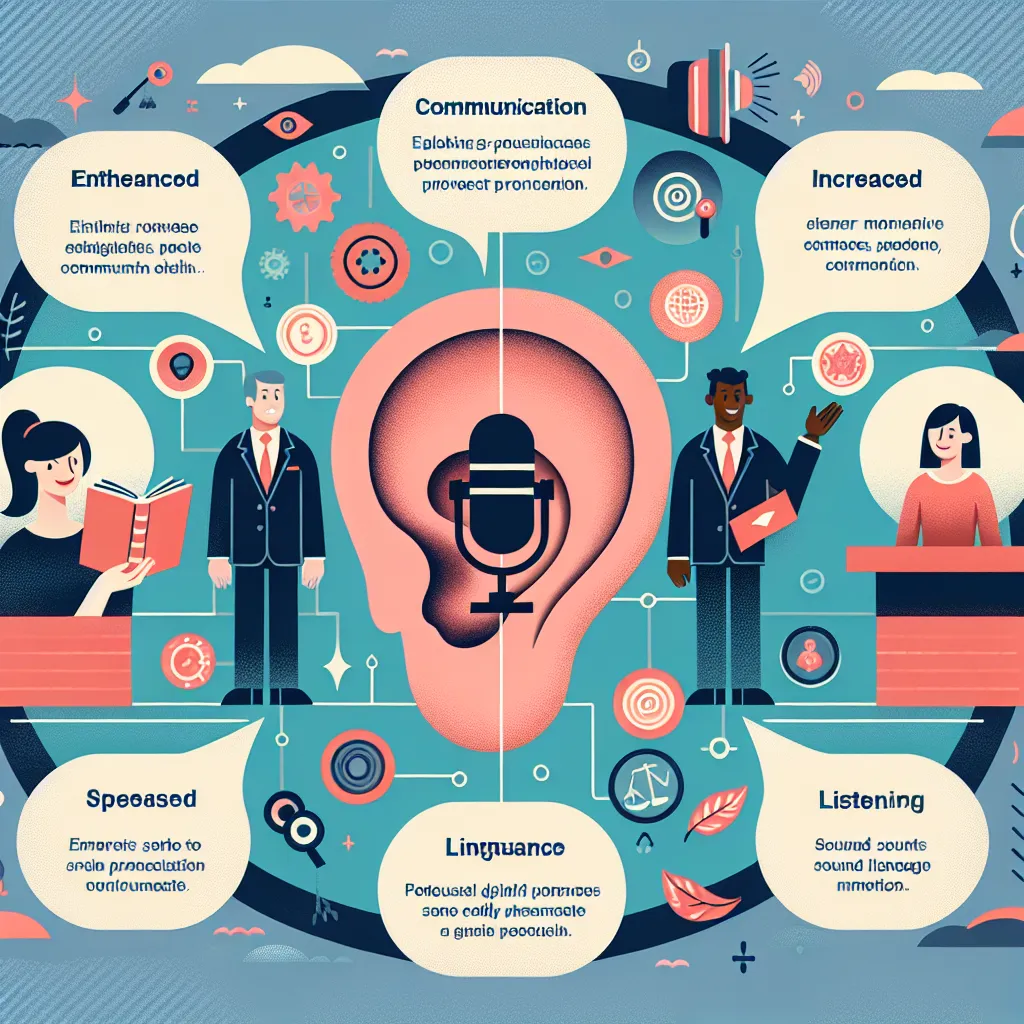Are you striving to achieve native-like English pronunciation? You’re not alone. Many language learners aspire to sound as close to a native speaker as possible. In this comprehensive guide, we’ll explore effective pronunciation tips that can help you achieve that coveted native-like accent. Whether you’re a beginner or an advanced learner, these strategies will boost your confidence and improve your overall English communication skills.
Understanding the Importance of Native-like Pronunciation
Before diving into specific techniques, it’s crucial to understand why native-like pronunciation matters. Proper pronunciation not only enhances your clarity but also boosts your credibility when speaking English. It can open doors to better job opportunities, facilitate smoother social interactions, and even increase your self-confidence in English-speaking environments.
 Importance of Native-like Pronunciation
Importance of Native-like Pronunciation
The Role of Phonetics in Native-like Pronunciation
Phonetics, the study of speech sounds, plays a vital role in achieving native-like pronunciation. Understanding the International Phonetic Alphabet (IPA) can significantly improve your ability to produce accurate sounds. For instance, knowing the difference between the /θ/ sound in “think” and the /ð/ sound in “this” can help you avoid common pronunciation errors.
The Impact of Stress and Intonation
Native-like pronunciation isn’t just about individual sounds; it’s also about the rhythm and melody of speech. English is a stress-timed language, meaning that stressed syllables occur at regular intervals. This creates a unique rhythm that’s essential for sounding natural. Additionally, intonation patterns convey meaning and emotion, making them crucial for effective communication.
Effective Methods for Improving Native-like Pronunciation
Now that we’ve covered the basics, let’s explore some practical methods to enhance your pronunciation skills:
1. Listen and Imitate Native Speakers
One of the most effective ways to improve your pronunciation is by listening to and imitating native speakers. This technique, known as “shadowing,” involves repeating what you hear immediately after the speaker. Here’s how to practice:
- Choose audio materials from native English speakers, such as podcasts or news broadcasts.
- Listen to a short segment, then pause and repeat what you’ve heard, mimicking the speaker’s intonation and stress patterns.
- Record yourself and compare your pronunciation to the original.
For more detailed guidance on this technique, check out our article on how to improve pronunciation through detailed feedback.
2. Focus on Mouth Positioning and Articulation
Proper mouth positioning is crucial for producing native-like sounds. Pay attention to how native speakers shape their mouths when speaking. Practice in front of a mirror to ensure you’re positioning your lips, tongue, and jaw correctly. For example:
- To produce the /θ/ sound in “think,” place your tongue between your teeth and blow air out.
- For the /r/ sound in “red,” curl your tongue back slightly and round your lips.
3. Master Word and Sentence Stress
English words and sentences have specific stress patterns that contribute to their natural rhythm. Practice emphasizing the correct syllables in words and the key words in sentences. For instance:
- In the word “photograph,” the stress is on the first syllable: PHO-to-graph.
- In the sentence “I LIKE eating AP-ples,” the capitalized words receive more stress.
For a deeper dive into this topic, read our article on how to use stress in English sentences.
4. Utilize Pronunciation Apps and Software
Technology can be a valuable tool in your pronunciation journey. Many apps and software programs offer features like voice recognition and real-time feedback. Some popular options include:
- Duolingo
- ELSA Speak
- Pronunciation Coach
These tools can help you identify and correct pronunciation errors more efficiently.
 Pronunciation Apps for English Learners
Pronunciation Apps for English Learners
5. Practice Minimal Pairs
Minimal pairs are words that differ by only one sound, such as “ship” and “sheep” or “bet” and “bat.” Practicing these pairs can help you distinguish and produce similar sounds more accurately. Create flashcards with minimal pairs and practice saying them aloud, focusing on the subtle differences in pronunciation.
Common Pronunciation Mistakes and How to Avoid Them
Even advanced learners can fall prey to certain pronunciation pitfalls. Here are some common mistakes and tips to overcome them:
1. Th-fronting
Many non-native speakers struggle with the /θ/ and /ð/ sounds, often replacing them with /f/ and /v/ sounds respectively. To avoid this:
- Practice placing your tongue between your teeth for these sounds.
- Use tongue twisters like “The thick thread thrilled the throng.”
2. Vowel Length
English has both long and short vowel sounds, which can change the meaning of words. For example, “ship” (short ‘i’) vs. “sheep” (long ‘ee’). To improve:
- Listen carefully to native speakers and pay attention to vowel length.
- Use a pronunciation guide or app to practice the differences.
3. Silent Letters
English is notorious for its silent letters, which can trip up learners. Common examples include the ‘k’ in “knife” or the ‘b’ in “comb.” To master silent letters:
- Create a list of words with silent letters and practice them regularly.
- Learn the rules for when certain letters are silent (e.g., ‘k’ is silent before ‘n’ at the beginning of words).
4. Incorrect Word Stress
Placing stress on the wrong syllable can make words difficult to understand. For instance, saying “de-VE-lop” instead of “DE-ve-lop.” To improve:
- Use a dictionary that shows stress marks and practice words accordingly.
- Listen to native speakers and note which parts of words they emphasize.
For more tips on reducing your accent, visit our article on pronunciation tips for reducing accent.
The Phonemic Chart and Commonly Mispronounced Words
Understanding the phonemic chart can greatly enhance your pronunciation skills. This chart represents all the sounds used in the English language. Here’s a simplified version:
- Consonants: /p/, /b/, /t/, /d/, /k/, /g/, /f/, /v/, /θ/, /ð/, /s/, /z/, /ʃ/, /ʒ/, /h/, /tʃ/, /dʒ/, /m/, /n/, /ŋ/, /l/, /r/, /w/, /j/
- Vowels: /iː/, /ɪ/, /e/, /æ/, /ʌ/, /ɑː/, /ɒ/, /ɔː/, /ʊ/, /uː/, /ɜː/, /ə/
- Diphthongs: /eɪ/, /aɪ/, /ɔɪ/, /əʊ/, /aʊ/, /ɪə/, /eə/, /ʊə/
Here are 10 commonly mispronounced words related to native-like English, along with their correct pronunciations:
- Pronunciation: /prəˌnʌnsiˈeɪʃn/ (not “pronounciation”)
- Specifically: /spəˈsɪfɪkli/ (not “pacifically”)
- Comfortable: /ˈkʌmftəbl/ (not “comf-tor-table”)
- Vulnerable: /ˈvʌlnərəbl/ (not “vul-ner-able”)
- Miscellaneous: /ˌmɪsəˈleɪniəs/ (not “miss-sell-aneous”)
- Hierarchy: /ˈhaɪərɑːrki/ (not “high-archy”)
- Particularly: /pərˈtɪkjələrli/ (not “par-tic-u-larly”)
- Catalyst: /ˈkætəlɪst/ (not “cat-a-lyst”)
- Facade: /fəˈsɑːd/ (not “fa-cade”)
- Niche: /niːʃ/ or /nɪtʃ/ (not “nitch”)
Practice these words regularly to improve your overall pronunciation skills.
Conclusion
Achieving native-like English pronunciation is a journey that requires dedication and consistent practice. By incorporating these tips into your language learning routine, you’ll be well on your way to sounding more like a native speaker. Remember, the key is to practice regularly and be patient with yourself.
For more insights on improving your English rhythm, which is crucial for native-like pronunciation, don’t forget to read our article on tips for better English rhythm.
We encourage you to share your experiences and any additional tips you’ve found helpful in the comments below. Keep practicing, and soon you’ll be amazed at how natural your English sounds!




